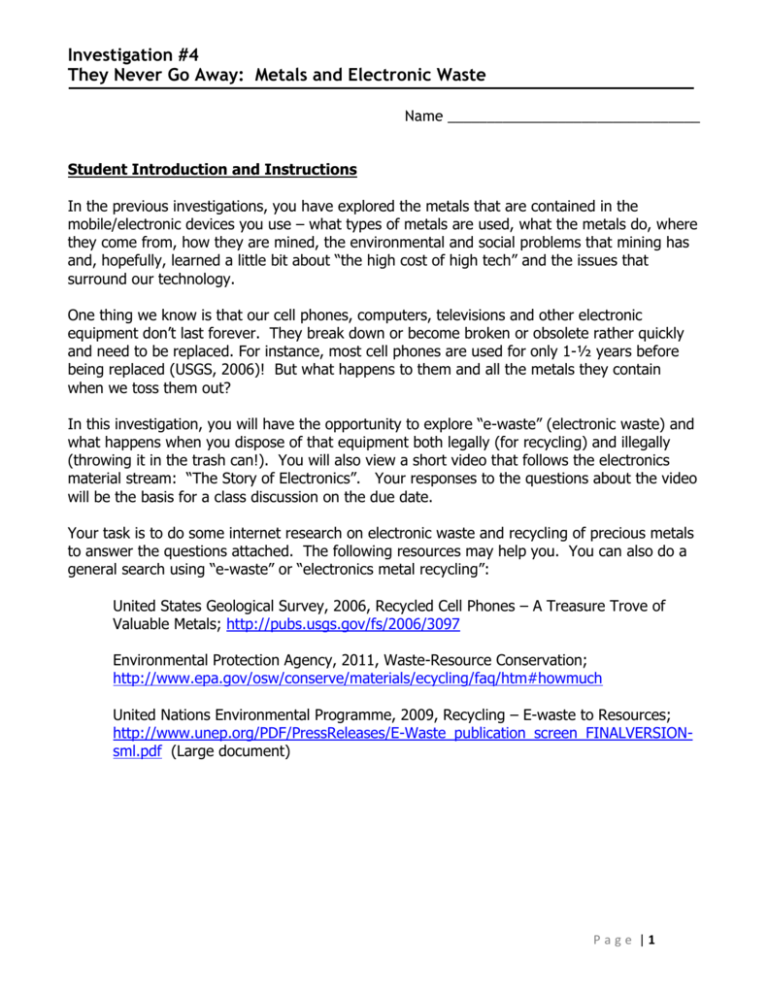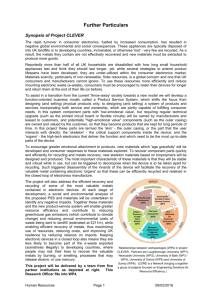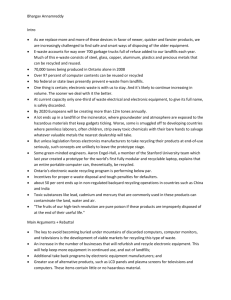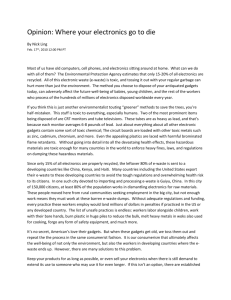They Never Go Away: Metals and Electronic Waste
advertisement

Investigation #4 They Never Go Away: Metals and Electronic Waste Name ________________________________ Student Introduction and Instructions In the previous investigations, you have explored the metals that are contained in the mobile/electronic devices you use – what types of metals are used, what the metals do, where they come from, how they are mined, the environmental and social problems that mining has and, hopefully, learned a little bit about “the high cost of high tech” and the issues that surround our technology. One thing we know is that our cell phones, computers, televisions and other electronic equipment don’t last forever. They break down or become broken or obsolete rather quickly and need to be replaced. For instance, most cell phones are used for only 1-½ years before being replaced (USGS, 2006)! But what happens to them and all the metals they contain when we toss them out? In this investigation, you will have the opportunity to explore “e-waste” (electronic waste) and what happens when you dispose of that equipment both legally (for recycling) and illegally (throwing it in the trash can!). You will also view a short video that follows the electronics material stream: “The Story of Electronics”. Your responses to the questions about the video will be the basis for a class discussion on the due date. Your task is to do some internet research on electronic waste and recycling of precious metals to answer the questions attached. The following resources may help you. You can also do a general search using “e-waste” or “electronics metal recycling”: United States Geological Survey, 2006, Recycled Cell Phones – A Treasure Trove of Valuable Metals; http://pubs.usgs.gov/fs/2006/3097 Environmental Protection Agency, 2011, Waste-Resource Conservation; http://www.epa.gov/osw/conserve/materials/ecycling/faq/htm#howmuch United Nations Environmental Programme, 2009, Recycling – E-waste to Resources; http://www.unep.org/PDF/PressReleases/E-Waste_publication_screen_FINALVERSIONsml.pdf (Large document) Page |1 Investigation #4 They Never Go Away: Metals and Electronic Waste The Problem of E-waste and Precious Metal Recycling Your task is to do some internet research on electronic waste and recycling of precious metals to answer the following questions. You can also do a general search using “e-waste” or “electronics metal recycling”. The following resources will get you started! Wikipedia, 2011, Electronic Waste; http://en.wikipedia.org/wiki/Electronic_waste United States Geological Survey, 2006, Recycled Cell Phones – A Treasure Trove of Valuable Metals; http://pubs.usgs.gov/fs/2006/3097 Environmental Protection Agency, 2011, Waste-Resource Conservation; http://www.epa.gov/osw/conserve/materials/ecycling/faq/htm#howmuch United Nations Environmental Programme, 2009, Recycling – E-waste to Resources; http://www.unep.org/PDF/PressReleases/E-Waste_publication_screen_FINALVERSIONsml.pdf (Large document) 1. Identify and list the types of materials categorized as “electronic” waste. 2. Is it legal to throw electronic devices into your trash can so that it ends up in the local municipal solid waste landfill? Why or why not? 3. Describe the problems caused by electronic wastes disposed of in landfills? 4. Approximately how many cell phones in the United States are “retired” each year? What percentage of these cell phones is recycled? 5. List the metals typically recycled from the cell phones. What is the approximate amount and market value of the metals? 6. Why is most electronic waste, like cell phones, not recycled? 7. Describe any social, political, environmental, or economic issues that arise as the result of recycling of e-waste? Page |2 Investigation #4 They Never Go Away: Metals and Electronic Waste The Story of Electronics “The Story of Electronics” is an 8 minute video that looks at the “life cycle” of electronic products. The video is part of the Story of Stuff Project and can be streamed live at their website: http://storyofstuff.org/electronics. It is also available on You Tube. Your task is to watch the video and respond to the following questions. We will be having a class discussion about the video on the due date. 1. The video claims that many electronic products are “Designed for the Dump”. What does this mean? Do you agree that companies do this? What would the benefit of designing for the dump be? 2. What happens to most e-waste that is recycled? Where does it end up? 3. It it legal to export waste to other countries? Why isn’t most e-waste recycled here in the U.S.? 4. The video discusses “externalizing costs”. What does it mean when a company externalizes costs? 5. Do you think that extended producer responsibility or take-back laws are a good idea? What are the benefits and negatives for a company that may result from these laws? 6. Is there any part of the material stream process that you feel you have any control over? What could you do to influence change in a positive way. 7. This video is obviously told from a specific viewpoint. What is the motivation behind the video? Do you agree with it? Why or why not? Page |3








